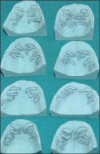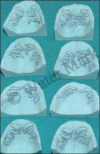Image manipulation: Fraudulence in digital dental records: Study and review
- PMID: 24696587
- PMCID: PMC3970385
- DOI: 10.4103/0975-1475.127767
Image manipulation: Fraudulence in digital dental records: Study and review
Abstract
Introduction: In present-day times, freely available software allows dentists to tweak their digital records as never before. But, there is a fine line between acceptable enhancements and scientific delinquency.
Aims and objective: To manipulate digital images (used in forensic dentistry) of casts, lip prints, and bite marks in order to highlight tampering techniques and methods of detecting and preventing manipulation of digital images.
Materials and methods: Digital image records of forensic data (casts, lip prints, and bite marks photographed using Samsung Techwin L77 digital camera) were manipulated using freely available software.
Results: Fake digital images can be created either by merging two or more digital images, or by altering an existing image.
Discussion and conclusion: Retouched digital images can be used for fraudulent purposes in forensic investigations. However, tools are available to detect such digital frauds, which are extremely difficult to assess visually. Thus, all digital content should mandatorily have attached metadata and preferably watermarking in order to avert their malicious re-use. Also, computer alertness, especially about imaging software's, should be promoted among forensic odontologists/dental professionals.
Keywords: Digital images; detection; manipulation; validation.
Conflict of interest statement
Figures







Similar articles
-
Digital image fraudulence: A curse to forensic odontology.J Forensic Dent Sci. 2018 May-Aug;10(2):67-70. doi: 10.4103/jfo.jfds_16_18. J Forensic Dent Sci. 2018. PMID: 30745779 Free PMC article. Review.
-
Detecting the manipulation of digital clinical records in dental practice.Radiography (Lond). 2017 Nov;23(4):e103-e107. doi: 10.1016/j.radi.2017.05.003. Epub 2017 Jun 3. Radiography (Lond). 2017. PMID: 28965903
-
Recent advances in digital image manipulation detection techniques: A brief review.Forensic Sci Int. 2020 Jul;312:110311. doi: 10.1016/j.forsciint.2020.110311. Epub 2020 May 7. Forensic Sci Int. 2020. PMID: 32473526 Review.
-
Digital analysis of bite marks and human identification.Dent Clin North Am. 2001 Apr;45(2):327-42, ix. Dent Clin North Am. 2001. PMID: 11370458
-
Dental identification using digital images via computer network.Am J Forensic Med Pathol. 2000 Jun;21(2):178-83. doi: 10.1097/00000433-200006000-00017. Am J Forensic Med Pathol. 2000. PMID: 10871136
Cited by
-
Gatekeepers of the academic world: a recipe for good peer review.Adv Med Educ Pract. 2015 Apr 16;6:329-30. doi: 10.2147/AMEP.S83887. eCollection 2015. Adv Med Educ Pract. 2015. PMID: 25926765 Free PMC article. No abstract available.
-
Digital image fraudulence: A curse to forensic odontology.J Forensic Dent Sci. 2018 May-Aug;10(2):67-70. doi: 10.4103/jfo.jfds_16_18. J Forensic Dent Sci. 2018. PMID: 30745779 Free PMC article. Review.
-
Digital Smile Design.J Pharm Bioallied Sci. 2022 Jul;14(Suppl 1):S43-S49. doi: 10.4103/jpbs.jpbs_164_22. Epub 2022 Jul 13. J Pharm Bioallied Sci. 2022. PMID: 36110736 Free PMC article. Review.
-
A simple working type Integrated Rugoscopy Chart proposed for analysis and recording rugae pattern.J Forensic Dent Sci. 2016 Sep-Dec;8(3):171-172. doi: 10.4103/0975-1475.195106. J Forensic Dent Sci. 2016. PMID: 28123273 Free PMC article. No abstract available.
References
-
- Keiser-Neilsen S. Bristol: John Wright and Sons; 1980. Person Identification by Means of Teeth.
-
- Güneri P, Akdeniz BG. Fraudulent management of digital endodontic images. Int Endod J. 2004;37:214–20. - PubMed
-
- Fiete R. “Photo Fakery” oemagazine [Internet] 2005. Jan, [Last cited on 2012 Dec 12]. Available from: http://spie.org/x16032.xml?highlight=x2410andArticleID=x16032 .
-
- Singbal KP, Chhabra N, Madan B. Digital Imagery: Reality or Fakery. Int J Contemp Dent. 2010;1:93–8.
LinkOut - more resources
Full Text Sources
Other Literature Sources
